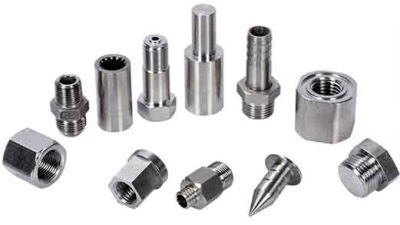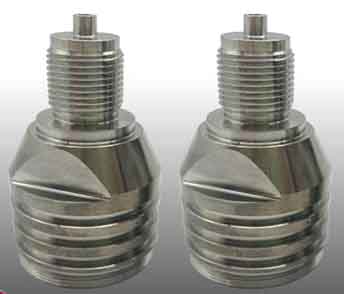CNC 터닝 스테인리스 나사의 문제점과 대책
CNC 터닝 나사의 표면 거칠기가 너무 나쁩니다.. CNC 터닝 스테인레스 스틸 스레드에서 발생하는 가장 일반적인 현상은 다음과 같습니다.: 비늘같은 잔물결과 칼로 물어뜯는 현상. 이러한 현상의 원인은 다음과 같습니다.:
(1) The clearance angles of the two sides of the thread turning tool are too small, and the friction between the two sides of the cutting tool and the rear thread surface will deteriorate the machined surface. The influence of the thread rotation angle on the actual clearance angle of both edges must be considered during processing.
(2) The rake angle of the thread turning tool is too small and the cutting edge is not sharp enough. The chips cannot be cut smoothly, but are partially squeezed or torn off, which must cause the thread surface to be very rough. When the front angle is too large, the strength of the blade is weakened and it is easy to wear, chip, and pierce the knife, which is more likely to cause vibration and cause ripples on the thread surface. 그러므로, 스테인레스 스틸의 다양한 재질에 따라 적절한 경사각을 선택해야 합니다.. 내농황산성 스테인리스강 나사 선삭 시, 2Cr13 스테인리스강 나사를 선삭하는 것보다 작은 경사각을 사용해야 합니다.. 선삭 공구 양쪽의 절삭날은 절삭날의 급격한 마모를 방지하기 위해 매우 좁은 절삭날을 가져야 합니다.. 2Cr13 절단시, 1Cr17, 4Cr13, 절단면은 최대한 날카로워야 합니다., 그렇지 않으면 필요한 우수한 표면 거칠기를 달성하는 것이 쉽지 않습니다..

스테인레스 스틸 나사 선삭 공정
(3) 실 자르는 칼날이 무뎌졌네요, 사실은, 경사각, 여유각은 큰 것에서 작은 것까지, 가혹한 성형 과정에서 압착된 칩, 절삭 진동이 증가하면 절삭력이 증가합니다., 가공된 표면의 심각한 열화. 그러므로, when turning stainless steel threads, the blade must be kept sharp at all times and the cutter head must be replaced in time.
(4) Insufficient fixation of threaded turning tools, excessively extended tool heads, insufficient tool arbor rigidity, poor machine tool accuracy, loose spindles, loose tool holders and other factors can cause vibration and cause ripples on the threaded surface. 그러므로, you must pay attention to the operation of the machine tool, cutting tool and workpiece during operation to make the system sufficiently rigid. When installing the turning tool, in addition to ensuring a firm installation and no looseness, the tip of the turning tool should be slightly higher than the center of the workpiece by 0.2-0.5mm, and never lower than the center to avoid cutting the tool.
(5) Avoid using the straight forward method when turning stainless steel threads. Due to the long chip contact length on the left and right sides, it is prone to vibration, which increases the load on the tool tip, causes vibration and increases the resistance during chip removal, and scratches the surface of the workpiece. 그러므로, for the processing of stainless steel threads, it is best to choose the method of cross-turning threads. This method adopts the alternate lateral feed method, especially for the cutting of large-pitch threads and viscous materials. It is the most effective measure to solve the vibration problem. Since the cutting edges are used crosswise, the wear is even and the tool life can be prolonged.
(6) CNC가 스테인레스 스틸 나사를 절단하는 과정에서 절단량의 일치 정도는 가공 효율성에 직접적인 영향을 미칩니다.. 절단량이 너무 적은 경우, 공구 마모가 악화됩니다, 그리고 너무 크면, 도구가 무너질 것입니다. 그러므로, 절삭 횟수와 절삭당 이송은 나사 회전에 결정적인 영향을 미칩니다.. 최고의 공구수명을 얻기 위해서는, 공작물 직경은 주요 나사 직경 0.14mm보다 커서는 안 됩니다., 그리고 공구당 이송은 0.05mm 미만은 피해야 합니다.. 가공을 위한 총 절삭량은 약 0.1mm 정도로 설정해야 합니다., 첫 번째 절단 깊이는 다음과 같아야 합니다. 150-200% 노즈 반경의 (아르 자형), 최대값은 0.5mm를 초과해서는 안 됩니다.. 오스테나이트계 스테인리스강용, 0.08mm 미만의 절단당 이송은 피해야 합니다.. Common edge inserts with a small nose radius for internal threads may increase the number of cuts as the depth of the tool decreases. Thread size is unstable after CNC turning stainless steel. After thread processing. Use a thread ring gauge to measure that the “through end” of the external thread cannot be entered, or there are phenomena such as inconsistencies in the front and rear tightness and partial passage of the “stop end”.

Cooling lubricant for turning stainless steel thread
Reasons for these ills of thread:
(1) The thread profile is wrong. Even if the pitch diameter of the thread has reached the specified size, the thread ring gauge and plug gauge may still not be screwed.
(2) The thread is inverted. When measuring with a thread gauge, 방향성에 제약을 받는 현상이 자주 발생합니다.. 즉 말하자면, 한쪽 끝은 조이고 다른 쪽 끝은 느슨해집니다., 그리고 심지어는 “through end” 통과할 수 없지만 “stop end” 대신 통과.
(3) 암나사의 밑면 직경이 너무 작은 경우, 또는 수나사의 바닥 직경이 너무 큽니다., 스레드 게이지가 나사로 고정되지 않습니다.. 이는 터닝 공구가 마모되어 무뎌지기 때문입니다., 절단 과정에서 압출이 발생합니다., 이는 나사산의 외경 또는 내경이 버에서 빠져 나오도록 만듭니다..
(4) 직경이 작은 암나사를 선삭할 때, 터닝 툴바의 강성은 크기에 따라 제한됩니다.. 돌리는 과정에서, 생산하기 쉽다 “칼을 주다”, 심지어 로컬 크기도 크다, which causes the local tolerance to be out of tolerance.
(5) When turning the stainless steel slender screw, due to the poor rigidity of the workpiece, deformation occurs during the turning process, resulting in dimensional errors on the thread.
(6) When turning the internal and external threads of stainless steel thin-walled workpieces, the workpiece will be locally deformed due to the force and cutting temperature, and the thread will also be locally out of tolerance. 그러므로, in order to solve the problem of “the thread gauge cannot enter”, corresponding measures must be taken for the above reasons, mainly from the aspects of correct installation and proper clamping of the workpiece.
The subtle role of cooling lubricating fluid in CNC thread cutting
Reasonable use of lubricating fluid can improve cutting conditions and achieve a multiplier effect. Attention should be paid when CNC cutting stainless steel threads:
Special requirements for cooling lubricants:
(1) Due to the toughness of stainless steel and the difficulty of being separated by cutting, the coolant is required to have higher cooling performance to take away a lot of heat.
(2) Due to the high viscosity and high fusion property, it is easy to produce built-up edge during thread cutting, so the coolant should have high lubricating performance.
(3) The coolant is required to have good permeability, which can penetrate into the fine gap lines of the metal area during cutting, so that the chips are easily broken.
(4) It must have a certain washing function.
Use several suitable coolants
(1) Vulcanized oil has good cooling performance and lubricating performance, and can be divided into direct and indirect according to different preparation methods. The formula of direct fluidized oil is 98% mineral oil and 2% sulfur. The indirect sulfurized oil formula is: mineral oil 78%-80%, black engine oil, vegetable oil 18%-20%, and sulfur 1.7%.
(2) F43 oil is suitable for cooling and lubricating stainless steel cutting, and has the best effect on stainless steel threads. The formula is: 아니요. 5 high-speed motor oil 83.5%, calcium petroleum sulfonate 4%, barium petroleum phosphate 4%, oxidized petroleum fat barium soap 4%, zinc dialkylthiophosphate 4%, and disulfide 0.5%.
(3) Vegetable oil, such as soybean oil, helps to obtain better thread surface roughness and prolong tool life when turning threads.
요약하자면, whether it is martensitic stainless steel, ferritic stainless steel or austenitic stainless steel, 또는 심지어 오스테나이트계 + 페라이트계 스테인리스강, 해당 스레드 처리 방법은 다양한 금속 구조에 따라 개발되어야 합니다. . 이상적인 처리 효과를 달성하기 위해, 더 많은 경제적, 사회적 이익 창출.
 English
English العربية
العربية 中文(漢字)
中文(漢字) Čeština
Čeština Dansk
Dansk Nederlands
Nederlands Suomi
Suomi Français
Français Deutsch
Deutsch Italiano
Italiano 日本語
日本語 ಕನ್ನಡ
ಕನ್ನಡ 한국어
한국어 Português
Português Русский
Русский Slovenčina
Slovenčina Español
Español Svenska
Svenska Türkçe
Türkçe

